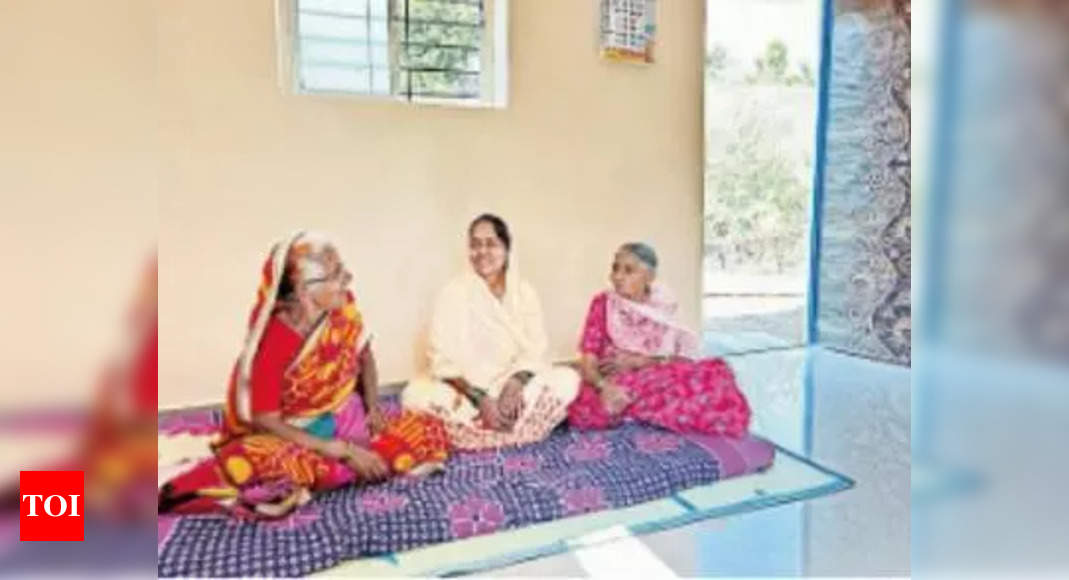
WWhen it poured heavily last monsoon, Nita Sanjay Shinde and her daughter Siddhi, 13, spent one night in horror. Not only did their ramshackle hut leak, but a big serpent also crawled in, making them cry. Mercifully, a neighbour saved them from the poisonous creature’s bites.
They no longer have to worry about rains or reptiles as they have a proper roof over their heads. Thanks to the initiative of NGO Habitat for Humanity India, Nita and 73 others in 28 villages in Khed taluka in Pune district, around 225 km from Mumbai, have pucca houses. Home to these poor villagers mean more than safe, secure shelters. “The biggest relief this house provides me is the sense of security and privacy. Earlier, I was more worried about my daughter as we didn’t have a proper bathroom. Now the attached toilet-bathroom is a big boon,” said Shinde, a daily wager in a farm. A year after the birth of her daughter, Shinde separated from her husband as he married another woman. Initially, she lived with her brother. “My parents gifted me this piece of land, but I didn’t have the money to build a house. Now my daughter can concentrate on her studies while I earn bread with dignity,” said Shinde. It is needy and vulnerable individuals like Shinde whom Habitat for Humanity India tries to bail out. “Home is a basic need. Widows and single mothers without resources are our priorities,” said Rajiv Raman, Habitat for Humanity India’s senior director (programme).
Before building the houses, mostly measuring 269 sqft, though the size increases if the need demands, the organisation involves the local gram panchayat to identify potential beneficiaries.
Saira Bano Pathan, 40, along with her mother Roshan (80) and stepmother Noorjahan (79), lived in a hut near her brother’s house. The tarpaulin-covered hovel would become unbearably hot during summer, and life became hellish in monsoon. Then Habitat intervened last year, and now all three live comfortably in a house allotted in Khed, Pune district.
Part of Habitat for Humanity International, a global housing organisation that has helped more than 59 million people construct, rehabilitate, or preserve their homes, the organisation gives vulnerable individuals and communities hope of owning their own homes. Jonathan T. M. Reckford, CEO of Habitat for Humanity International, earlier told TOI that since 2005, their local chapters in more than 70 countries have grown to helping more than 13.4 million people.
Habitat does not hunt for the land where houses are to be built but help them with proper shelters on the land that the gram panchayat provides,” said Satish Jadhav, their programme manager. Additionally, the funds received from Prime Minister’s Awas Yojana are added.
WWhen it poured heavily last monsoon, Nita Sanjay Shinde and her daughter Siddhi, 13, spent one night in horror. Not only did their ramshackle hut leak, but a big serpent also crawled in, making them cry. Mercifully, a neighbour saved them from the poisonous creature’s bites.
They no longer have to worry about rains or reptiles as they have a proper roof over their heads. Thanks to the initiative of NGO Habitat for Humanity India, Nita and 73 others in 28 villages in Khed taluka in Pune district, around 225 km from Mumbai, have pucca houses. Home to these poor villagers mean more than safe, secure shelters. “The biggest relief this house provides me is the sense of security and privacy. Earlier, I was more worried about my daughter as we didn’t have a proper bathroom. Now the attached toilet-bathroom is a big boon,” said Shinde, a daily wager in a farm. A year after the birth of her daughter, Shinde separated from her husband as he married another woman. Initially, she lived with her brother. “My parents gifted me this piece of land, but I didn’t have the money to build a house. Now my daughter can concentrate on her studies while I earn bread with dignity,” said Shinde. It is needy and vulnerable individuals like Shinde whom Habitat for Humanity India tries to bail out. “Home is a basic need. Widows and single mothers without resources are our priorities,” said Rajiv Raman, Habitat for Humanity India’s senior director (programme).
Before building the houses, mostly measuring 269 sqft, though the size increases if the need demands, the organisation involves the local gram panchayat to identify potential beneficiaries.
Saira Bano Pathan, 40, along with her mother Roshan (80) and stepmother Noorjahan (79), lived in a hut near her brother’s house. The tarpaulin-covered hovel would become unbearably hot during summer, and life became hellish in monsoon. Then Habitat intervened last year, and now all three live comfortably in a house allotted in Khed, Pune district.
Part of Habitat for Humanity International, a global housing organisation that has helped more than 59 million people construct, rehabilitate, or preserve their homes, the organisation gives vulnerable individuals and communities hope of owning their own homes. Jonathan T. M. Reckford, CEO of Habitat for Humanity International, earlier told TOI that since 2005, their local chapters in more than 70 countries have grown to helping more than 13.4 million people.
Habitat does not hunt for the land where houses are to be built but help them with proper shelters on the land that the gram panchayat provides,” said Satish Jadhav, their programme manager. Additionally, the funds received from Prime Minister’s Awas Yojana are added.



